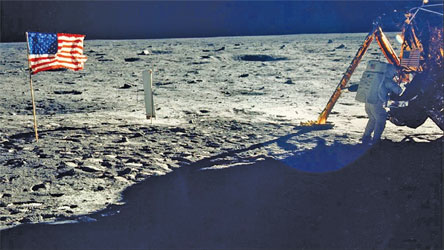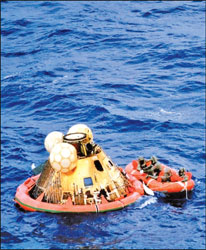|
Neil Armstrong:
The first man on Beyond the moon...

The moon bids the Earth adieu:
 Mankind
has entered a new era of space exploration today with NASA’s latest
space rover Curiosity already on Mars, the Planet where the mythical
Martians or Extraterrestrials (ETs) live . It is at this crucial
juncture when the world is watching in awe the images sent back to Earth
by Curiosity, and the successful transmission of the first recorded
human voice (that of NASA’s chief, Charles Bolden), from Earth to Mars
and back that the space legend who created history by walking on the
moon bids the world adieu. The American astronaut, Neil Armstrong who
took that small step on the moon which was indeed a gigantic step for
mankind, is no more. He died at the age of 82 on August 25 in
Cincinnati, Ohio . He once set the world ablaze with euphoria when he
stepped down from the spacecraft onto the moon but now he has draped the
world in a veil of mourning. So, as we mourn the death of this iconic
astronaut among US astronauts and even the Russian cosmonauts of the
world, let’s step back in time to trace his journey to the moon . Mankind
has entered a new era of space exploration today with NASA’s latest
space rover Curiosity already on Mars, the Planet where the mythical
Martians or Extraterrestrials (ETs) live . It is at this crucial
juncture when the world is watching in awe the images sent back to Earth
by Curiosity, and the successful transmission of the first recorded
human voice (that of NASA’s chief, Charles Bolden), from Earth to Mars
and back that the space legend who created history by walking on the
moon bids the world adieu. The American astronaut, Neil Armstrong who
took that small step on the moon which was indeed a gigantic step for
mankind, is no more. He died at the age of 82 on August 25 in
Cincinnati, Ohio . He once set the world ablaze with euphoria when he
stepped down from the spacecraft onto the moon but now he has draped the
world in a veil of mourning. So, as we mourn the death of this iconic
astronaut among US astronauts and even the Russian cosmonauts of the
world, let’s step back in time to trace his journey to the moon .
It all began with President John F Kennedy’s commitment to the nation
“to achieving the goal, before the decade is out, of landing a man on
the moon and returning him safely to Earth.” It was done with more than
five months to spare. And on July 20, 1969 the historic journey to the
moon was taken by Neil Armstrong and fellow astronauts Edwin “Buzz”
Aldrin and Michael Collins. They blasted off in Apollo 11 on a nearly
250,000-mile journey to the moon that kept the whole world on edge until
they safely reached their destination. It took them four days to reach
the moon. It was not just the NASA officials at the space centre in
America but the entire world that watched and waited anxiously as the
lunar module “Eagle” separated from the command module and began its
descent. Then came the words from Armstrong: “Tranquillity Base here,
the Eagle has landed.”
“Roger, Tranquillity,” mission control replied. “We copy you on the
ground. You’ve got a bunch of guys about to turn blue. We’re breathing
again. Thanks a lot.”And what an achievement that proved to be for all
of humankind. Then after about six and a half hours later at 10:56 p.m.
ET (on July 20), came the most significant moment...Neil Armstrong who
was 38years at that time became the first man to set foot on the moon.
He and his fellow astronaut who followed him could be seen bounding like
kangaroos in the low lunar gravity,which is one sixth that of the
Earth’s.

Those of us who were fortunate to watch him take that historic small
step also became part of that golden moment It was beamed to nearly
every country around the world via a satellite . It was truly the first
global mass media event with an estimated 600 million people — one of
every five on the planet watching it. The now famous phrase “That’s one
small step for (a) man, one giant leap for mankind.” were uttered by him
at that historic moment. The quote was originally recorded without the
“a,” which was picked up by voice recognition software many years later.
Can you even imagine how exciting it would have been to really walk
on the moon we can only see and admire from a distance?Armstrong is
recorded to have been on the surface of the moon for two hours and 32
minutes and Aldrin, who followed him, spent about 15 minutes less than
that. However, the third astronaut , the command ship pilot, Michael
Collins, did not have the opportunity to actually walk on the moon. He
remained in orbit about 60 miles overhead, waiting their return
Armstrong and Aldrin set up an American flag, scooped up moon rocks and
set up scientific experiments before returning to the main spacecraft.
They also left a patch to commemorate NASA astronauts and Soviet
cosmonauts who had died in pursuit of space. All three returned home to
a hero’s welcome, and none ever returned to space. A crater near the
landing site is named in Armstrong’s honour.
The plaque the US astronauts left on the moon read: “Here men from
the planet Earth first set foot upon the moon. July 1969 A.D. We came in
peace for all mankind.”What a remarkable feat. For all mankind. And
that’s how the world took it.
|
 
The blast off, moonwalk and splash down to Earth |
Armstrong received the Presidential Medal of Freedom in 1969, the
highest award offered to a U.S. civilian .After his historic mission to
the moon, Armstrong worked for NASA, coordinating and managing the
administration’s research and technology work.
In 1971, he resigned from NASA and taught engineering at the
University of Cincinnati for nearly a decade. While many people are
quick to cash in on their 15 minutes of fame, Armstrong largely avoided
the public spotlight and chose to lead a quiet, private life with his
wife and children. Neil Armstrong walked where no man had walked before
and blazed the trail for all of humankind.
For 25,000 years, humans have been migrating and pushing into new
places. Armstrong took it to new heights. After his moonwalk in 1969, 12
American astronauts have walked on the moon between then and the Apollo
17 mission in 1972.
So, now that Neil Armstrong has gone to his rest, perhaps, beyond the
moon, it is not only the world that will miss this space legend ,but
maybe even the moon because, after all he is the first man from the
Earth to have left his footprints on its surface.

“Neil was among the greatest of American heroes - not just of his
time, but of all time.When he and his fellow crew members lifted off
aboard Apollo 11 in 1969, they carried with them the aspirations of an
entire nation. They set out to show the world that the American spirit
can see beyond what seems unimaginable - that with enough drive and
ingenuity, anything is possible.
-President Barack
Obama.
As long as there are history books, Neil Armstrong will be included
in them.As we enter this next era of space exploration, we do so
standing on the shoulders of Neil Armstrong. We mourn the passing of a
friend, fellow astronaut and true American hero.
-Charles Bolden,
NASA’s
administrator.
“He was the best, and
I will miss him terribly,”
- Michael Collins, the Apollo 11 command module pilot.
“The two historical events likely to be long remembered from the 20th
century are the moon landing and the first atomic bomb. There is no way
to overestimate that significance in human history, and he is forever
linked to that”.
- Roger Launius,
Smithsonian Institution space curator.
“Just as the voyage of Christopher Columbus split historic eras 500
years ago, so will Armstrong and Apollo 11.We may be living in the age
of Armstrong”
-Douglas Brinkley,
Rice University historian( a specialist in 20th-century history.)
“One of the great divides in human history; we are sundered from it
forever by the moment when Neil Armstrong and Buzz Aldrin stepped out on
to the Sea of Tranquility. Now history and fiction have become
inexorably intertwined.”
-Arthur C. Clarke, the
late science fiction author wrote on the Apollo 11 moon landing .
Biodata
Neil Alden Armstrong was born on August 5, 1930, in the small town of
Wapakoneta, Ohio, to Stephen Armstrong and the former Viola Louise
Engel. His father was a state auditor.At the age of 6, Neil and his
father took a ride in a Ford Trimotor airplane, known as the Tin Goose.
It must have made an impression. He earned his pilot’s licence at the
age of 16.
He became an Eagle Scout when the family later moved back to
Wapakoneta, where he finished high school.The town now has a museum
named for him. From there, he went to Purdue University as an
engineering student on a Navy scholarship. His college years were
interrupted by the Korean War.Soon after his graduation he married Janet
Elizabeth Shearon, in January 1956.They had two sons, Eric and Mark, who
survive.
A daughter, Karen, died of an inoperable brain tumour in 1962. The
couple were divorced in 1994. In 1999, Armstrong married Carol Knight.He
had been hired as an experimental test pilot for the National Advisory
Committee on Aeronautics, the forerunner of the National Aeronautics and
Space Administration, at Edwards Air Force Base. His first flight in a
rocket plane was in the Bell X-1B, a successor to the plane Yeager had
first flown faster than the speed of sound., Armstrong was the backup
commander for Apollo 8, the first flight to circumnavigate the Moon,
doing so at Christmastime in 1968.
It was the mission that put Apollo back on track after a cockpit fire
during a launching pad rehearsal had killed three astronauts in January
1967. And it put Armstrong in position to command Apollo 11.
Facts and pix: Internet

|


